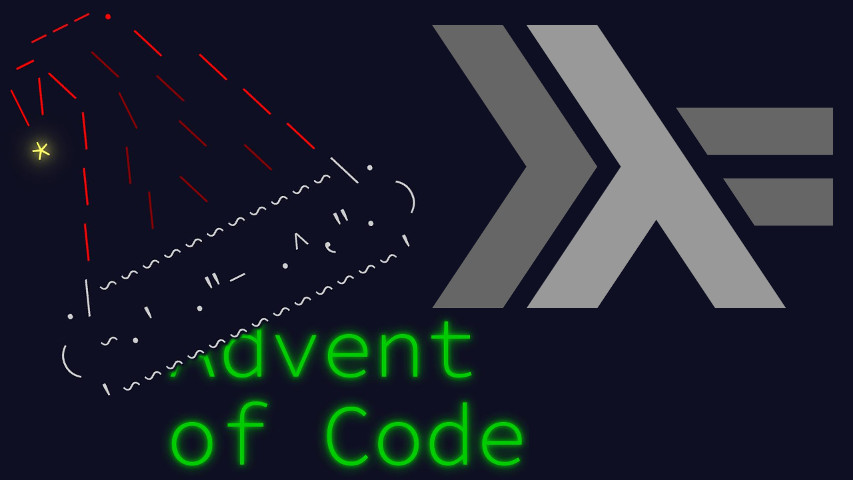In today’s Advent of Code puzzle, “Beacon Exclusion Zone”, we’ll be performing some interval arithmetic to achieve reasonable times rasterizing a fairly large bitmap.
This post is literate Haskell, with a few imports to begin with.
import Control.Applicative (liftA2)
import Control.Lens ((^.),view)
import Data.Char (isDigit)
import Data.List (nub,sort,uncons)
import Data.Maybe (mapMaybe)
import Data.Monoid (Alt(Alt))
import Linear.V2 (V2(V2),_x,_y)
import Numeric.Interval hiding (empty)
import Prelude hiding (null)I’m barely doing anything with coordinates, but using
Linear makes it so seamless anyway it’s not worth
avoiding.
type V = V2 IntI’ll also throw in the most point-free abusive implementation of Manhattan distance.
dist :: V -> V -> Int
dist = ((sum . fmap abs) .) . (-)Our input is provided as a list of reports, each one revealing the position of a distinct sensor, and the position of the nearest beacon it detects.
data Report = Report { _sensor :: V, beacon :: V }I’ll keep with the month’s style of terse optimistic parsing.
parse :: String -> [Report]
parse = map report . lines where
report (words -> ["Sensor","at",sx,sy,"closest","beacon","is","at",bx,by]) =
Report (V2 (pos sx) (pos sy)) (V2 (pos bx) (pos by))
pos = read . takeWhile isNumber . dropWhile (not . isNumber)
isNumber = liftA2 (||) (== '-') isDigitFor part 1, we’re counting the number of positions on a given horizontal line where we know for sure there isn’t a beacon.
Let’s split the problem and first identify which positions on a horizontal line are covered by a single sensor’s sweep. I’ll first compute its Manhattan radius, then reduce it for eccentricity, then make an interval out of it, centered on the beacon’s X coordinate.
scanSensorOnLine :: Int -> Report -> Maybe (Interval Int)
scanSensorOnLine y (Report sensor beacon) =
let radius = dist sensor beacon
radius' = radius - abs (sensor^._y - y)
in if radius' < 0 then Nothing else Just (sensor^._x +/- radius')The +/- operator would gracefully yields an empty
interval when called on a negative argument, but I’ll go further and
eliminate those right here before they’re even produced so I can more
easily merge the ones that overlap when aggregating coverage intervals
from all sensors.
scanLine :: Int -> [Report] -> [Interval Int]
scanLine y = mergeOverlaps . mapMaybe (scanSensorOnLine y)I’ll use a short helper to ensure all intervals we’re left with are separate.
mergeOverlaps :: Ord a => [Interval a] -> [Interval a]
mergeOverlaps is0 = maybe [] (uncurry go) (uncons (sort is0)) where
go i (i':is) | not (null (intersection i i')) = go (hull i i') is
| otherwise = i : go i' is
go i [] = [i]The count of positions where there can’t be a beacon is then easily computed by summing the intervals’ size, and removing any beacons known to be on the scanned line.
part1 :: [Report] -> Int -> Int
part1 reports scanY =
let beacons = nub (beacon <$> reports)
in sum (map (succ . width) (scanLine scanY reports))
- length (filter ((== scanY) . view _y) beacons)For part 2, we’re asked for the hypothetical single position in a four-million-positions-wide square that isn’t in reach of our sensor array.
There are lots of smart and efficient ways to do this, but to ssolve the puzzle just once they’d be a waste of engineering time: my overlap merging is efficient enough that I can just scan the four million lines and detect the first hole.
part2 :: [Report] -> Int -> Alt Maybe Int
part2 reports size = flip foldMap [0..size] $ \y -> Alt $
case intersection (0...size) <$> scanLine y reports of
[i1,i2] | distance i1 i2 == 2 -> Just (tuningFrequency (sup i1 + 1) y)
[i] | i == (0...size) -> NothingThe above cases are enough to solve, since, for various reasons, the hole is necessarily off the square’s side borders. But here’s a bit of paranoia coverage for the case it is on one of the side borders:
| inf i > 0 -> Just (tuningFrequency 0 y)
| sup i < 20 -> Just (tuningFrequency size y)And a bit of additional paranoia in case I failed at my interval arithmetic:
[] -> error ("No sensor at all covers line " ++ show y)
_ -> error ("Multiple coverage holes in line " ++ show y)A small checksum is all that’s needed to present the result in the format the puzzle expects.
tuningFrequency :: Int -> Int -> Int
tuningFrequency x y = 4000000*x + yLet’s wrap it up in a main, with an unpleasant “if”
because the statement example input and the puzzle inputs are not
subject to the same rules:
main :: IO ()
main = do
reports <- parse <$> getContents
let (scanY,size)
| length reports <= 15 = (10,20)
| otherwise = (2000000,4000000)
print $ part1 reports scanY
print $ part2 reports sizeAnd that’s enough to reap the stars!
It runs in a few seconds, so it’s obviously pretty far from optimal. From here, the typical route to speed would read something like this:
Optimize the raster aspect out by using space partitioning techniques or another form of constructive geometry. The puzzle duality between Manhattan (sensors) and Chebyshev (scan) distances is likely to make that more painful than it’s worth, however.
A more “competitive programming” route would exploit the fact the number of reports is very small (I have 33), so the cardinality of interesting sectors in the grid is also quite small (O(N2)).
And, of course the real pros out there exploited the structure inferred from the what the puzzle requests as an answer. Check out the reddit thread for spoilers.
All of this does make this puzzle a prime target for revisiting. But that’s a task for another day. See you tomorrow!



